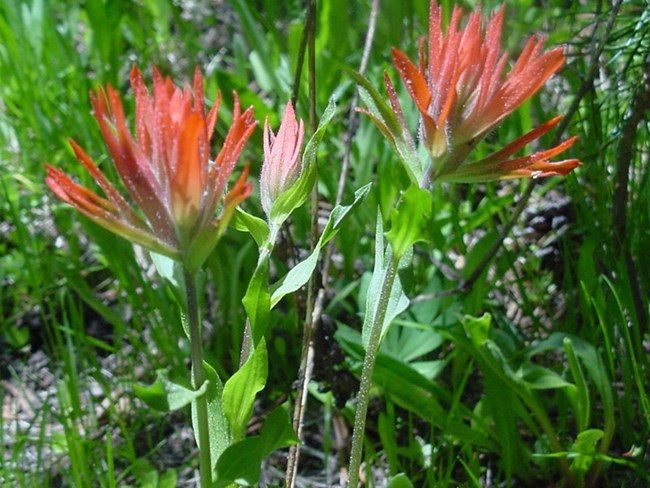Last updated: January 29, 2024
Article
Common Red Paintbrush

NPS/Neal Herbert
General Description
Have you ever been on a hike, walking through a meadow, surrounded by green and brown plants, and seen a bright flash of red in the distance? You get closer and see that the red comes from a flower. Red lines stick out from the stem, like a firework or a sunburst. It is so brightly colored that it looks almost as if it was dipped in paint, like a paintbrush.
Castilleja miniata is known by many common names, including “common red paintbrush,” “giant red Indian paintbrush,” “meadow paintbrush,” and “scarlet paintbrush.” This plant is in the broomrape (Orobanchaceae) family and is part of a group of flowers with the genus “Castilleja” and the common name “Indian paintbrushes.” The broomrape family includes more than 2000 species, the majority of which are parasitic.
Common red paintbrush grows between 20 and 80 cm tall (~8–30 inches) and has flat, lance-shaped leaves called “bracts” with tiny hairs on them. The color of these bracts ranges from bright red to pale orange. Common red paintbrush is a perennial—meaning it grows back every year—herbaceous plant. Bees and hummingbirds, which pollinate this flower, are attracted to its bright colors as well as the nectar supply at the base of its floral tube.
Habitat and Distribution
Common red paintbrush grows in the United States from Alaska to Arizona and is common in the Pacific Northwest. Its habitat ranges from open woods and meadows, to thickets, grassy slopes, tidal marshes, clearings, gravel bars, and roadsides. It can grow at low, middle, and high elevations. Common red paintbrush blooms from March to October.

NPS photo
Ecology
One unique ecological trait of common red paintbrush is that it is a hemiparasite,
or partial parasite, meaning that it obtains some of its food from a host and also produces its own food through photosynthesis. The roots of common red paintbrush establish connections with the roots of neighboring species, and through this connection, common red paintbrush obtains the other plants’ nutrients and water. This ability to take water from other plants allows common red paintbrush to survive in dry conditions and to expand its geographic range. This reliance on other plants makes common red paintbrush difficult to transplant or to grow from seeds.
Historically, many Native American tribes, including the Gitksan Tribe of British Columbia, have used Castilleja flowers to treat various illnesses, such as bleeding and coughing, and as a condiment on food. However, their leaves and roots contain selenium, which can be toxic if eaten.
Common red paintbrush is currently not a species of conservation concern.
Fun Facts
- C. miniata can sometimes be mistaken for other species of Indian paintbrush, for example, seashore paintbrush (C. litoralis). Seashore paintbrush is common on seaside bluffs in Oregon and looks like C. miniata but has stems curved at the base and hairy lance- or egg-shaped leaves.
- Alpine paintbrush (C. rhexifolia) also resembles C. miniata but is usually less than 30 cm tall and can be crimson to purple. It grows at high elevations along the coast and Cascade Mountains.
- The genus name “Castilleja” is named for 18th century Spanish botanist Domingo Castillejo. The species name “miniata” comes from the word “minium” for a kind of red lead paint that was used to paint illuminated manuscripts in the Middle Ages.
Where to See
You can see common red paintbrush in Crater Lake National Park, Lassen Volcanic National Park, Oregon Caves National Monument and Preserve, and Redwood National and State Parks.
Learn More

Download a pdf of this article.
Prepared by Jeri Stoller, Scientists in Parks intern
NPS Klamath Inventory & Monitoring Network
Southern Oregon University
1250 Siskiyou Blvd
Ashland, OR 97520
Featured Creature Edition: October 2023
